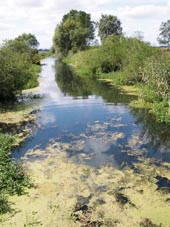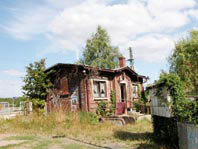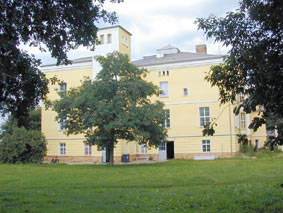












Paulinenaue is not the typical Havelland village, even though people settled here in primitive times on the sandy island at the fringe of the fen, which is documented by archaeological finds. The village was recorded in a document of the Bredows as 'Heideberge' between Lindenholz and the village Lützow, which burned down around 1372. Around 1420 Heideberge belonged to the estate of Knoblauch as Bardelebensche dairy farm, named after the family Bardeleben, who governed the land around Selbelang between 1412 and 1833. On the 30th of April 1833 the estate got the name Paulinenaue, in honour of Pauline von Bardeleben, who married the Pessiner squire von Knoblauch. Dominated by agriculture, especially dairy the village with its only 115 inhabitants experienced an enormous up-swing through the building of the railway line Berlin–Hamburg. The first train travelled through Paulinenaue on the 15th of October 1846. First houses for the railway worker were constructed and when the private railway Paulinenaue–Neuruppin through the Luch started working Paulinenaue became interchange station and terminal for all kind of goods to Berlin. Paulinenaue became famous worldwide through a spectacular record:

On the 11th of May 1936 a travelled with the steam engine 05002 between Vietznitz and Paulinenaue with 200,4 km/h. 190 trains run in 24 hours on this line among them also the 'Flying Hamburger'. Mewrited for the economical up-swing was the work of the family Werner, who came from Werder and introduced in 1901 fruit, strawberry and asparagus growing. Max Schmeling liked to come to Paulinenaue in the thirties for skeet shooting. The name of the Berlin chemistry Professor Johannes Goldschmidt is also connected with Paulinenaue. He developed in his workshop in the Ruppiner Straße 9 the thermite welding, which is still used today for rail welding. One of the many owners of the Paulinenaue estate was since 1924 also a Dr. Schurig, a progressive agronomist who water surfaces for intensive vegetable growing and was also successful in beef production, pig fattening and poultry production. The undamaged estate was taken over by the Red Army after the 2nd World War for the accommodation of their soldiers. War confusion brought the well-known Mitscherlich professor for soil science to Paulinenaue. He became in 1949 director of the new academy-Institute for the increase of plant production. Today, 1.328 inhabitants live in Paulinenaue and the village of Selbelang at the fringe of the fen is the natural habitat for great bustards, penduline tits and marsh harriers. Also very attractive is the Lindenholz, the protected deciduous forest of the village. A nature trail points to botanical rarities like the greenish wood hyacinth and the great two-leaf amidst the cowslips, lily of the valley and liverwort. The settlement Bienenfarm points maybe to early beekeeper, today it is a little airfield.

Part of the community Paulinenaue is the village Selbelang, also situated at the Havelland-cycle-hiking path. Its name has nothing to do with the devil's legend and is of Slavic origin, it points to turtles and bog, which were still here well into the 19th century. From 'suluelanc' in 1335 became 1541 Selvelank. The village houses the palace of the former manor, whose distillery, today operated by Märkischen Hof GbR, was in GDR times connected with the brand 'Bärensiegel'. The Märkische Hof GbR, a successor of the VEG, operates in the village cattle breeding. The stable liquid manure as well as refuse from the distillery are being processed in a modern biogas plant. A local feeding stuff factory stands for progressive technology and the vocational training centre also schools specialists for Eastern Europe. Well worth seeing is the listed St. Nicolai church, built around 1440 with an altar from 1717 and an organ from 1804. Engaged citizens collected money for its preservation and repair as the exterior shows threatening cracks. further >>
The pictures + contents of this page were kindly made available by
Stadtmagazinverlag AS GmbH
.
Photo: Stadtmagazinverlag AS